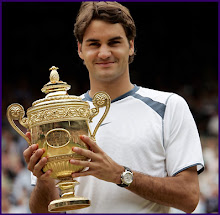
Beginners should aim most of their shots toward
their opponent's weakest stroke, which is often the
backhand. |
Trying to raise your game isn’t necessarily the best option when you face a player who’s giving you more than you can handle.
The first thing most players do when they find themselves trailing in a match is look for things that will help them raise their level of play. The problem with that strategy is that players typically start matches using their A game, so switching to something else usually means they end up using a tactic that’s the second- or third-best choice for their style of play. I’ve found that the smartest players react in a different way when they’re behind: Rather than trying to lift their own level, they focus on lowering their opponent’s. Here are some ways to win ugly.
BEGINNER
OBJECTIVE 1: Keep the ball in play.
When you’re just starting to play tennis, you can win many matches simply by being more consistent than your opponent. Mastering the concept of shot tolerance—knowing how many balls your opponent will hit before he feels he has to go for a winner—should be first on the todo list of all developing players. While shot tolerance varies from player to player, hitting three or four balls on a point is often all it takes to push a beginner out of his comfort zone and cause him to take a risk that, more often than not, will result in an error.
OBJECTIVE 2: Isolate and destroy
Isolation is the tactic of identifying and exploiting your opponent’s vulnerabilities. At the beginner level the most glaring weaknesses are often particular shots, such as the backhand or the volley. Once you identify the chinks in your opponent’s game, hit the majority of your shots to those soft spots. Making your opponent hit shots he’s uncomfortable with should bring down the rest of his game.

Use underspin to test your
opponent's timing and
technique. |
INTERMEDIATEOBJECTIVE 1: Master the moonball
While many intermediate players know how to play aggressively from the baseline, few have learned the skills needed to attack when given a steady diet of high, looping balls with plenty of topspin—aka the dreaded moonball. These difficult-to-handle shots force your opponent to move back from the base-line, giving him fewer angles and less pace to work with. Consequently, moonballs often lower your opponent’s level of play by depriving him of the opportunity to attack while simultaneously forcing him to be more patient than he might like to be.
OBJECTIVE 2: Use slice and underspin
Have you ever seen someone come off the court bragging about how well he played against a guy who sliced and diced? I haven’t either. The fact is, most players absolutely hate to compete against opponents who hit a lot of junk. Why? Slice and under-spin shots are not as easy to handle as they appear. Sure, they look like they would be easy to attack, but because they bounce lower and slower than topspin shots, slices take you out of your rhythm. Hitting aggressively against these shots requires well-grooved technique and excellent timing, abilities most intermediates don’t have. Changing spins is one of the most effective ways to lower your opponent’s level of play.

Drop shots can lure advanced players into
the forecourt on your terms. |
ADVANCEDOBJECTIVE 1: Serve to the weaker side
It’s not uncommon for advanced players to have a 5.0 forehand and a 4.0 backhand. Discovering whether this is true for your opponent will give you a huge advantage. Think about it: If you pay attention and hit your serves to your opponent’s weaker return side, you can deter-mine if you’re going to be playing a 5.0 player or a 4.0 player as you start each point in your service game. The last thing you want to do when you’re trailing in a match is to give your opponent an opportunity to hit his best shot.
OBJECTIVE 2: Develop a drop shot
This may seem like a tactic best suited for a lower level of play, but remember that most advanced play-ers prefer to hit from the baseline. If you can make your opponent come to net on your terms, you can force him to beat you from a part of the court where he’s uncomfortable. Re-member to use the drop shot to get your opponent off the baseline, not to try to end the point outright. If a winner is your goal, the drop shot is not the best choice.

